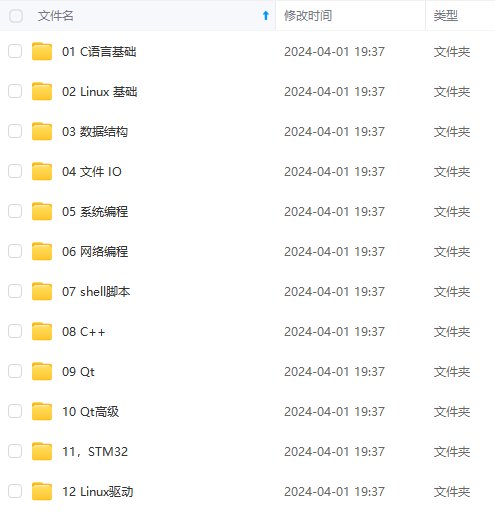

既有适合小白学习的零基础资料,也有适合3年以上经验的小伙伴深入学习提升的进阶课程,涵盖了95%以上物联网嵌入式知识点,真正体系化!
由于文件比较多,这里只是将部分目录截图出来,全套包含大厂面经、学习笔记、源码讲义、实战项目、大纲路线、电子书籍、讲解视频,并且后续会持续更新
手指方向检测(食指, 可以修改其他手指) 可以直接运行,这里的hands_module是单独检测左手或者右手,test_time检测时间就是超时返回0,last_dire是我项目里需要的参数,这应该是最快速的检测手指指向的方案了,包含了手指的方向以及手指是否直指,(食指一二三关节关键点夹角)这里是手指关节必须大于140度
效果图:

手指指向判断时候,cvzone手势识别有,手掌21个关键点的三维坐标,所以这里利用的是三维向量判断和对应角度夹角,这里三维向量∠ABC需要满足需求才表示指向某个方向。

检测最大的那只手,指向判断,完成功能。
# -*- coding: utf-8 -*-
import cv2
import time
import numpy as np
import cvzone.HandTrackingModule
import cvzone.FaceDetectionModule
from collections import Counter
face_detector = cvzone.FaceDetectionModule.FaceDetector(minDetectionCon=0.5)
hand_direction_detector = cvzone.HandTrackingModule.HandDetector(mode=False, # 视频流图像
maxHands=4, # 最多检测两只手
detectionCon=0.5, # 最小检测置信度
minTrackCon=0.7) # 最小跟踪置信度
def detect_hand_direction(cap_hand_direction, hands_module=1, last_dire=5, test_time=5):
print("开始指向检测")
reference_vectors = [np.array([0, -1, 0]), np.array([1, 0, 0]),
np.array([-1, 0, 0]), np.array([0, 1, 0])] # 3D坐标单位向量
angles = []
add_count = [1, 1, 1, 1]
left_hand_direction = [0, 0, 0, 0]
right_hand_direction = [0, 0, 0, 0]
video_model = 1 # 是否显示视频
if 0 < last_dire < 5: # 平常是5 不作数, 如果对应了某一个方向,那就让对应方向检测次数更多
add_count[last_dire-1] = 1/3
# 清除之前的视频流数据
frames_to_skip = 2 # 要丢弃的帧数
for _ in range(frames_to_skip):
_, _ = cap_hand_direction.read()
atime = time.time()
while True:
success, frame = cap_hand_direction.read()
if success is not True:
break
hands = hand_direction_detector.findHands(frame, draw=False, flipType=False)
if hands:
left_hand_max_area = 0 # 初始化最大面积为0
right_hand_max_area = 0 # 初始化最大面积为0
left_hand_max_index = -1 # 初始化最大面积对应的遍历序号为-1
right_hand_max_index = -1 # 初始化最大面积对应的遍历序号为-1
left_region_status = 0 # 初始化左手是否在范围内
right_region_status = 0 # 初始化右手是否在范围内
for index, hand in enumerate(hands):
if hand["type"] == "Left": # 左手
_, _, w_left, h_left = hand["bbox"]
left_hand_area = w_left * h_left # 计算面积
if left_hand_area > left_hand_max_area:
left_hand_max_area = left_hand_area
left_hand_max_index = index
if hand["type"] == "Right": # 右手
_, _, w_right, h_right = hand["bbox"]
right_hand_area = w_right * h_right # 计算面积
if right_hand_area > right_hand_max_index:
right_hand_max_index = right_hand_area
right_hand_max_index = index
if hands_module == 2 and left_hand_max_index != -1:
# 模式2 只检测左手
# # 采用食指的第一关节[7]第二关节[6]第三关节即指根[5]来求出 食指第二关节的角度 计算食指弯曲角度
# # 将夹角余弦值转换为角度制并输出夹角
ab = np.array(hands[left_hand_max_index]["lmList"][6]) - np.array(
hands[left_hand_max_index]["lmList"][7])
bc = np.array(hands[left_hand_max_index]["lmList"][5]) - np.array(
hands[left_hand_max_index]["lmList"][6])
cos_angle = np.dot(ab, bc) / (np.linalg.norm(ab) * np.linalg.norm(bc))
angle = 180 - np.arccos(cos_angle) * 180 / np.pi
if angle > 140:
direction = np.array(hands[left_hand_max_index]["lmList"][5]) - np.array(
hands[left_hand_max_index]["lmList"][8])
angles.clear()
for reference_vector in reference_vectors:
cos_angle = np.dot(direction, reference_vector) / (
np.linalg.norm(direction) * np.linalg.norm(reference_vector))
angle = np.arccos(cos_angle) * 180 / np.pi
angles.append(angle)
# 判断手指朝向是否符合四个方向中的至少一个
if angles[0] < 45 <= max(angles): # 下
left_hand_direction.append(1)
elif angles[1] < 45 <= max(angles): # 左
left_hand_direction.append(2)
elif angles[2] < 45 <= max(angles): # 右
left_hand_direction.append(3)
elif angles[3] < 45 <= max(angles): # 上
left_hand_direction.append(4)
if len(left_hand_direction) >= 10:
counter = Counter(left_hand_direction) # 使用Counter计算每个数字的出现次数
most_common_digit = counter.most_common(1)[0][0] # 找到出现次数最多的数字
print("Most common digit:", most_common_digit)
return most_common_digit
if hands_module == 1 and right_hand_max_index != -1:
# 模式1 只检测右手
# 采用食指的第一关节[7]第二关节[6]第三关节即指根[5]来求出 食指第二关节的角度 计算食指弯曲角度
# # 将夹角余弦值转换为角度制并输出夹角
ab = np.array(hands[right_hand_max_index]["lmList"][6]) - np.array(
hands[right_hand_max_index]["lmList"][7])
bc = np.array(hands[right_hand_max_index]["lmList"][5]) - np.array(
hands[right_hand_max_index]["lmList"][6])
cos_angle = np.dot(ab, bc) / (np.linalg.norm(ab) * np.linalg.norm(bc))
angle = 180 - np.arccos(cos_angle) * 180 / np.pi
if angle > 140:
direction = np.array(hands[right_hand_max_index]["lmList"][5]) - np.array(
hands[right_hand_max_index]["lmList"][8])
angles.clear()
for reference_vector in reference_vectors:
cos_angle = np.dot(direction, reference_vector) / (
np.linalg.norm(direction) * np.linalg.norm(reference_vector))
angle = np.arccos(cos_angle) * 180 / np.pi
angles.append(angle)
# 判断手指朝向是否符合四个方向中的至少一个
if angles[0] < 45 <= max(angles): # 下
right_hand_direction.append(1)
elif angles[1] < 45 <= max(angles): # 左
right_hand_direction.append(2)
elif angles[2] < 45 <= max(angles): # 右
right_hand_direction.append(3)
elif angles[3] < 45 <= max(angles): # 上
**收集整理了一份《2024年最新物联网嵌入式全套学习资料》,初衷也很简单,就是希望能够帮助到想自学提升的朋友。**


**[如果你需要这些资料,可以戳这里获取](https://bbs.csdn.net/topics/618679757)**
**一个人可以走的很快,但一群人才能走的更远!不论你是正从事IT行业的老鸟或是对IT行业感兴趣的新人**
**都欢迎加入我们的的圈子(技术交流、学习资源、职场吐槽、大厂内推、面试辅导),让我们一起学习成长!**
资料,可以戳这里获取](https://bbs.csdn.net/topics/618679757)**
**一个人可以走的很快,但一群人才能走的更远!不论你是正从事IT行业的老鸟或是对IT行业感兴趣的新人**
**都欢迎加入我们的的圈子(技术交流、学习资源、职场吐槽、大厂内推、面试辅导),让我们一起学习成长!**






















 1万+
1万+

 被折叠的 条评论
为什么被折叠?
被折叠的 条评论
为什么被折叠?








